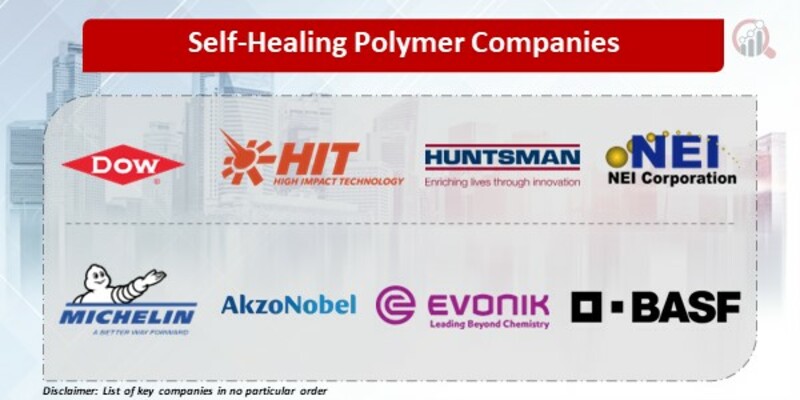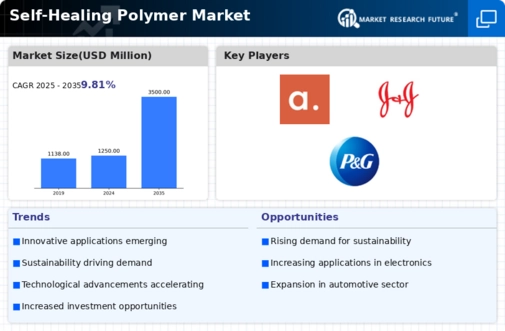Top Industry Leaders in the Self-Healing Polymer Market
 The self-healing polymer market, paints a picture of resilience and sustainability. These futuristic materials, capable of automatically repairing minor damage, are finding applications across diverse industries, from aerospace and automotive to electronics and medical devices. But beneath the surface of self-repair lies a competitive landscape as dynamic as the polymers themselves, where established giants and innovative startups grapple for market share.
The self-healing polymer market, paints a picture of resilience and sustainability. These futuristic materials, capable of automatically repairing minor damage, are finding applications across diverse industries, from aerospace and automotive to electronics and medical devices. But beneath the surface of self-repair lies a competitive landscape as dynamic as the polymers themselves, where established giants and innovative startups grapple for market share.
Strategies Seeding Growth:
-
Product Diversification: Companies like Dow Chemical, Arkema, and Evonik are pushing the boundaries with novel self-healing polymer formulations boasting enhanced repair mechanisms, compatibility with specific materials, and tailored functionalities. Think polymers that heal by heat, light, or even water exposure, catering to diverse environments and applications. -
Vertical Integration: Securing reliable sources of key monomers and additives crucial for self-healing properties is essential. Some players, like BASF, are investing in backward integration to gain control over the supply chain and optimize costs. -
Focus on Sustainability: Environmental consciousness is shaping the market. Companies are adopting greener production processes, using recycled materials, and developing bio-based self-healing polymers to minimize environmental impact and appeal to sustainability-driven customers. -
Technological Advancements: Research and development efforts are leading to next-generation healing mechanisms, novel encapsulation techniques for repair agents, and integration with nanomaterials for enhanced properties. Early adopters and innovators stand to benefit significantly from these advancements.
Factors Shaping the Market Mosaic:
-
Infrastructure and Construction Demand: These sectors remain primary drivers, with self-healing polymers offering extended lifespan and reduced maintenance costs for bridges, roads, and buildings. Technological advancements in construction materials create new opportunities for specialized self-healing solutions. -
Aerospace and Automotive Industries: The need for lightweight, robust materials with self-healing capabilities for aircraft and car components drives innovation in this segment. Stringent safety regulations further incentivize adoption of materials that can mitigate damage and prevent catastrophic failures. -
Regulation and Sustainability Push: Environmental regulations on waste and resource depletion coupled with consumer demand for durable and eco-friendly products are propelling the demand for self-healing polymers across diverse applications. -
Innovation and Differentiation: Developing self-healing polymers with unique repair mechanisms, functionalities like self-sensing or color change upon damage, and compatibility with existing materials is key to differentiation and customer retention.
Key Companies in the Self-Healing Polymer market include
-
The Dow Chemical Company
-
Covestro AG
-
High Impact Technology, LLC
-
Huntsman International LLC
-
Michelin Group
-
MacDermid Autotype Ltd.
-
Akzo Nobel N.V.
-
Evonik Industries Corp.
-
BASF SE
-
NEI Corp.
Recent Developments
-
September 2023: A fire at a major polymer production facility in Europe disrupts global supply chains, temporarily impacting production and prices of self-healing polymers. -
October 2023: A consortium of leading tech companies and universities launches a collaborative project to develop self-healing polymer coatings for electronic devices, extending their lifespan and reducing e-waste. -
November 2023: BASF unveils a bio-based self-healing polymer specifically designed for packaging applications, addressing the issue of plastic waste and promoting circular economy principles. -
December 2023: The self-healing polymer market shows signs of continued growth, with increasing investments in research and development, expanding application areas, and growing focus on sustainable solutions.









